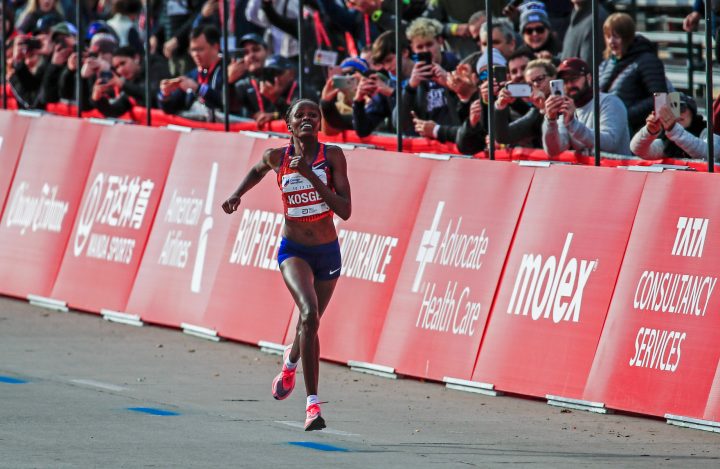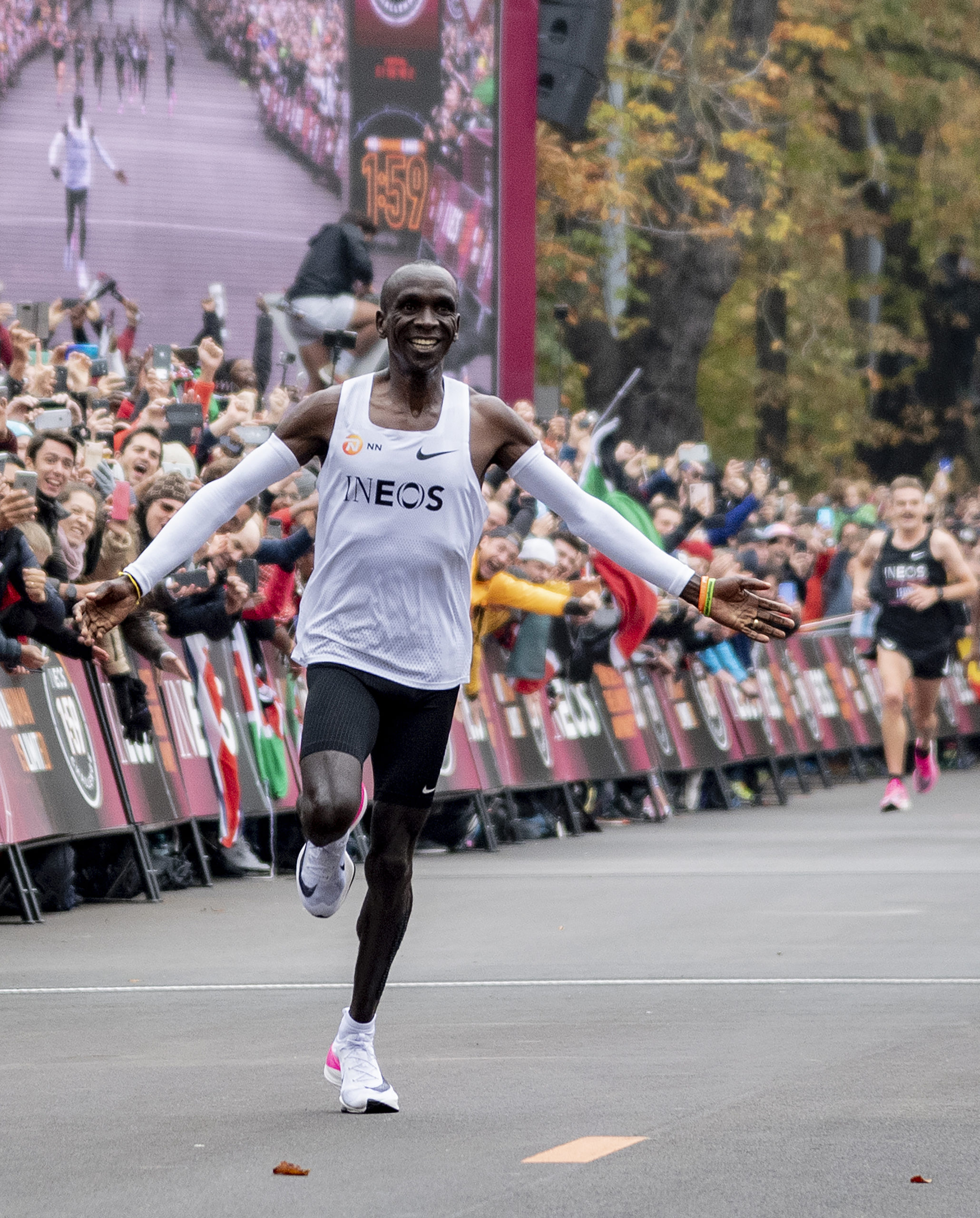Sport 168
Technology versus talent – the great shoe-volution

Shoe technology, more than ‘natural’ physiological gains, is reshaping athletics and performances. And it’s not a good thing.
First published in Daily Maverick 168
Marathon. Half-marathon, 15km, 10km, 5km on the road. One-hour run, 10,000m and 5,000m on the track. These are some of the world records that have fallen in the past two years. What they have in common is that their conquerors have worn one specific shoe. Never before has a sport so traditionally celebrated as a test of human performance been so overtaken by questions about technology.
If world record lists exist as a type of archaeological record for statisticians to examine, they will one day look at the period between 2017 and 2020 and conclude that a seismic event took place to change distance running, ushering in a new era. That event was the creation of super shoes.
In the beginning
It began in 2017, when Nike first put its weight behind the attempt to break the two-hour marathon barrier. A new shoe was part of that, but sceptics had seen and heard this before, and dismissed it as Nike trying to leverage the hype into selling more shoes.
Kenyan Eliud Kipchoge scared that two-hour barrier, appropriately on the Formula 1 motor racing circuit of Monza, thanks in part to a series of contrivances that included a bunch of pacemakers relaying in and out of the race to run in a “V-formation” to shelter him from the wind, a pancake-flat course with no sharp turns to slow him down, and fluids hand-delivered to bypass the inconvenience of veering off course or slowing down to drink. But it was the shoe that would soon emerge as the real star of the show.
First came the promised research. For once, a marketing claim about performance-enhancing shoes proved to have some substance behind it. At the time of its introduction, the shoe was said to have been called the 4% because laboratory studies had found that it improved something called running economy by that amount.

Eliud Kipchoge, Kenyan marathon world record holder, celebrates after the INEOS 1:59 Challenge in Vienna, Austria, 12 October 2019. EPA-EFE/CHRISTIAN BRUNA EDITORIAL USE ONLY
Running economy is the athlete’s equivalent of fuel economy in a car — it is the amount of oxygen used by the athlete to run one kilometre, and what exceptional distance runners have in common is that they’re all extremely economical. That, allied to a high VO2max (the maximum amount of oxygen a person can utilise during intense exercise) and a “lactate threshold” (think cruising capacity) are the key elements for the world’s greatest marathon runners.
A research study confirmed that what Nike had figured out was a way to reduce the cost of running at a given speed. Through a combination of a new foam material and a curved carbon-fibre plate, a runner could now achieve the same pace, but use less oxygen.
And by extension, the runner would be able to run faster before bumping up against the physiological ceilings that normally exist because of oxygen supply to the muscles. The 4% running economy advantage does not necessarily create a 4% performance advantage, but the estimate, based on laboratory research models, is for an improvement of 2% to 3%, or two to three minutes in a marathon. It would be like running slightly downhill when everyone else is on a flat road. Or like running with a pair of shoes that weighs only 100g when everyone else is weighed down by 400g shoes.
Game changer
It’s an advantage that transformed distance running, contributing to what has in effect been a recalibration of running performances. First it emerged that the 2016 Olympic podiums were owned by the shoe, despite it not being commercially available at that time.
The men’s marathon world record went to Kipchoge in 2018. Both the men’s and women’s half-marathon records were broken. In 2018 and 2019, virtually every major city marathon was won by an athlete wearing the shoe, most in new course records. Many athletes whose sponsorship deals were with other brands painted over the shoe upper to hide their disloyalty to their brands, just to have a chance at success.
Then the sub-two-hour barrier did fall to Kipchoge, in Vienna in October 2019; by then he was powered by a prototype of the third iteration of the shoe, the Alphafly Next%. The original 4% shoe, striking for its midsole thickness, was now even taller, with a 39mm “stack height” providing the “scaffolding” for the carbon plate, the elastic energy return of the foam, and serving also to lengthen the leg to further enhance running economy and performance.
A day later, the women’s marathon world record was toppled. Paula Radcliffe’s time, unbeaten for 16 years, was the last monument to a previous era; it was not edged but destroyed by Bridget Kosgei in the Chicago Marathon.
The same technology of foam and carbon-fibre plate found its way into the specialist spikes worn by athletes on the track, and 2020 has delivered the results — a women’s 5,000m world record, and men’s world records over 5,000m and 10,000m. The reality was impossible to ignore — running had been “recalibrated”.
The moral problem
That alone is problematic for a sport that relies heavily on times and history for its value. The value of a world record is that it represents a new horizon for human physiology and is celebrated as a barometer of progress.
Usually, that progress is understood to mean “the runner”. None would dispute that, over many generations, there is a progressive evolution of technology, knowledge and physiology, which makes it foolish to compare Jim Peters, the marathon champion in the 1950s, with Kipchoge and his peers.
However, the pace of this development was sudden. It happened within a generation, it was unprecedented in impact and it is completely independent of the athlete — the same runner, two days apart, might produce performances belonging to different eras, thanks to a shoe. That bothered many people.
Even more concerning is whether the shoes undermine the integrity of the result. It’s one thing for records to fall, and for times to be recalibrated such that a 2:05 marathon becomes routine rather than exceptional. At least if everyone had the same benefit, it would leave the fundamental premise of running intact. That premise is that the winner is the athlete whose physiology is superior on the day. Refined and optimised by training, running rewards physiology, and creates the perception of something relatively “pure”.
But super shoes challenge this premise, for two reasons. The first is that the shoes are not available to all. Initially, it was Nike that had the first-mover advantage. Other brands scrambled to make up lost ground, and most now have their own version, but they’ve had to negotiate regulations, patent laws and access to material barriers, and there remains no guarantee that they have closed the gap.
A difference of even 2% caused by shoes would be larger than the typical physiological difference between the top 10 athletes in the world, the result being that if you randomised the allocation of shoes among those 10 athletes, you could completely change the result of a race.
It would be analogous to watching Rafael Nadal outplay Novak Djokovic in Paris, knowing that if they were made to swap tennis rackets after two sets, it would be Djokovic sweeping Nadal off the court. It is anathema to running that technology affects the result more than physiology, but that is the implication if a degree of between-brand parity cannot be restored.
Second, when an item of equipment has the capacity to make such large differences to performance, it will invariably do so in groups of “high responders” and “low responders”. The former will see very large benefits — if the average advantage from the shoe is 2%, theirs may be 5%.
Others may see no benefit at all. This spread — five percentage points in this hypothetical scenario — is so large that it is, all by itself, decisive to a race outcome. No longer would the athlete breaking the tape be the best runner, physiologically and psychologically, but rather he or she would represent the best runner/shoe interaction.
Regulatory pushback
Faced with these dilemmas, authorities acted. Sort of. In January, World Athletics hit “pause” as it introduced regulations that would limit the thickness of the midsole and prevent the excessive, unregulated use of carbon-fibre plates. The controlling body’s upper limit for stack height, conveniently, is exactly the same as the height of the Nike shoes that have rewritten the record books since 2016, and provides enough room for a smart engineer to continue to innovate and explore ways to drive humans ever faster.
The regulations thus leave enough scope for the existing problems to persist, and potentially, for new problems to manifest. A more cautious approach would have been to imitate what swimming’s governing body did in 2010, when it banned hi-tech swimsuits after a similar set of outrageous performance leaps and distorted outcomes affected that sport in 2008 and 2009. The policy effectively rewound technology to a point where swimming ability, rather than swimmer/tech interface, would determine the result. World Athletics had the same opportunity, as it could have reduced the maximum allowable thickness of shoes to considerably less than the 40mm currently in place.
It did not, and so the sport moves forward at a pace driven more by engineers integrating super springy foam with carbon-fibre plates than by muscles, hearts, lungs and brains. DM168
Dr Ross Tucker is a sports scientist.



















 Become an Insider
Become an Insider
Comments - Please login in order to comment.